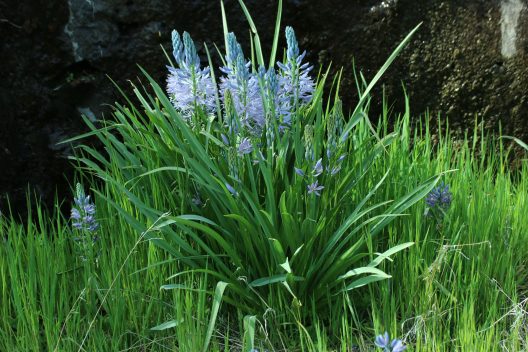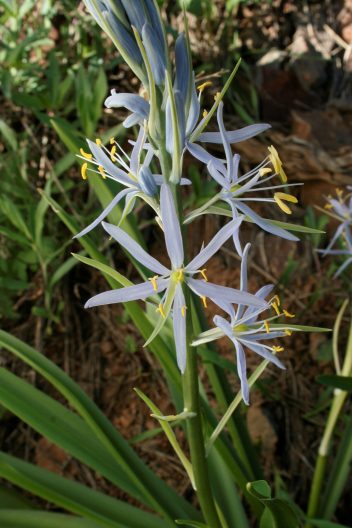Cusick’s Camas

By Paul Slichter
Local botanists have long recognized several patches of an odd camas growing above the Klickitat River. They didn’t quite match the Suksdorf’s camas (Camassia leichtlinii ssp. suksdorfii) or common camas (both C. quamash ssp. breviflora and ssp. quamash) which are the local camas in the area.
Fortunately, Susan Kephart, a specialist in camas taxonomy, was invited to look at the unusual camas by local plant enthusiast, Barbara Robinson. Susan quickly solved the mystery by noting that these were Cusick’s camas (Camassia cusickii) found far outside their range. Susan’s efforts to investigate camas species in western Klickitat County can be found in Volume 43, No. 1, the Spring 2019 Journal of the Washington Native Plant Society.
Cusick’s camas was originally considered endemic to the Snake River region of northeastern Oregon and west-central Idaho where it inhabits vernally moist montane slopes. It can be identified by the cluster of 10 or more leaves, long dense spikes of light blue flowers, and the mix of radially symmetrical and irregular flowers. The other local camas species have fewer than 10 leaves, less dense inflorescences, and differences to their respective flowers.
Cusick’s camas is a sensitive species in Washington. Little is known of its distribution. It is limited to an area about 5 to 10 miles long above the western edge of the Klickitat River. During the spring of 2021, a group of local Rare Care volunteers were invited to visit a property owned by Barbara Robinson near the town of Klickitat, WA. During the course of this late April hike Barbara directed us to a Cusick’s camas patch grouped along a seep on a steep cut bank of basalt above the river. We noted the plant characteristics, took photos, and I then wrote a brief monitoring report that was sent into Rare Care. This piqued the interest of Rare Care since it was the first monitoring report filed with them for this species.
This was a recreational hike, and we did not conduct a formal monitoring search. Such efforts will have to wait until 2022. Some of the populations will be easy to monitor as they are along trails and roadsides. But most are high up on steep, rocky slopes. One of Barbara’s hiking acquaintances has assured us that there are a number of populations awaiting adventurous plant monitors high above the river. Perhaps you will be one of those lucky enough to monitor this beautiful plant?
